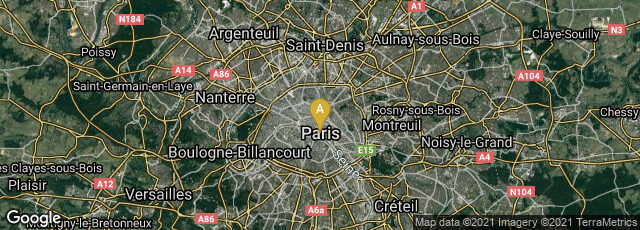

A: Paris, Île-de-France, France
In 1963 Argentine writer Julio Cortázar, writing in Paris, published Rayuela (English: Hopskotch), an introspective stream-of-consciousness novel with multiple endings that can be read in different ways. It was translated into English by Gregory Rabassa in 1966. This has been called the first hypertext novel, though the concept of hypertext hardly existed at the time.
"Written in an episodic, snapshot manner, the novel has 155 chapters, the last 99 being designated as "expendable." Some of these "expendable" chapters fill in gaps that occur in the main storyline, while others add information about the characters or record the aesthetic or literary speculations of a writer named Morelli who makes a brief appearance in the narrative. Some of the 'expendable chapters' at first glance seem like random musings, but upon closer inspection solve questions that arise during the reading of the first two parts of the book.
"An author's note suggests that the book would best be read in one of two possible ways, either progressively from chapters 1 to 56 or by "hopscotching" through the entire set of 155 chapters according to a "Table of Instructions" designated by the author. Cortázar also leaves the reader the option of choosing his/her own unique path through the narrative.
"Several narrative techniques are employed throughout the book, and frequently overlap, including first person, third person, and a kind of stream-of-consciousness. Traditional spelling and grammatical rules are often bent and sometimes broken outright. A few chapters purport to be written by other authors, and there is even a whole section taken almost verbatim from another novel that may or may not exist in actuality" (Wikipedia article on Hopskotch, accesseed 01-04-2014).
"I suppose it's unreasonable to expect the world's first so-called hypertext novel - one in which you can read the chapters sequentially, or in an order recommended by the author, or in any other order you choose - to have a compelling plot. After all, plot relies on anticipation and surprise, both of which come from authorial control over how and when information is revealed. A lot of the delight in fiction comes from this, and most of the rest from character, theme and the texture of the language. Cortazar's revolutionary novel is big on the last few, but not unexpectedly fails to be very engaging when it comes to story. It's more of a character study, or rather an elaboration of a philosophical position through the depiction of certain people in a particular place and time, i.e. left-leaning international emigres in 1950s Paris, and later the locals in Buenos Aires, who spend most of their time smoking, drinking, listening to jazz, competing for affection, philosophizing about life, and trying not to be the creative geniuses they obviously know they are. There are some wonderful set pieces: the infamous Chapter 28 involving a baby in a darkened room; the afternoon a plank bridge is erected to join two hotel rooms on opposite sides of a busy Buenos Aires street; an elaborate booby trap of water-filled basins, tangled threads and ball-bearings to thwart a vengeful lover in the night; and, obviously, the hopscotch squares of the title which are drawn in the courtyard of an insane asylum. These incidents are all engaging, comic, and wonderfully laden with a metaphorical/philosophical import which serves Cortazar's embedded theme: that is, the conundrum of consciousness; the unending desire to break through "the wall" to the other side of life in order to achieve the "unity" we intuitively feel exists but to which there is no easy path. This is the novel's engine, but it does take a while to fire up. If slowly savouring 500+ pages of that kind of thing interests you, then you'll enjoy "Hopscotch" immensely. If it doesn't, then reading this novel will be somewhat like being trapped at a really bad party with drunk and depressive philosophy undergraduates who think they know everything about jazz. I had the urge to leave early, but I'm glad I stayed until the end. Eventually, someone shut the music off, opened all the windows, and in the silence of dawn something clicked" (review by Steven Reynolds, December 31, 2004, on Amazon.com, accessed 01-04-2014).